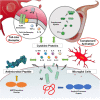Amyloid beta is an early responder cytokine and immunopeptide of the innate immune system
- PMID: 33163614
- PMCID: PMC7606184
- DOI: 10.1002/trc2.12100
Amyloid beta is an early responder cytokine and immunopeptide of the innate immune system
Abstract
A molecular level conceptualization of the pathogenesis of Alzheimer's disease (AD) remains elusive with many competing hypotheses, particularly via proteopathic and immunopathic mechanisms. However, these need not be competitive. If amyloid beta (Aβ) is regarded as an "early responder cytokine," then proteopathic considerations become encompassed within an overarching hybrid proteopathic-immunopathic mechanism. As argued in this commentary, Aβ is in fact a molecular constituent of the innate immune system. Aβ is an antimicrobial peptide (AMP) functioning not only as a killer peptide, but also as a modulatory immunopeptide. Aβ satisfies the definition of a cytokine, exhibiting interdependency with other cytokines. Aβ also satisfies the functional definition of a chemokine, existing within the AMP-chemokine spectrum. Aβ, like conventional cytokines, both binds to and is released by microglial cells. Finally, Aβ interacts with the complement and Toll-like receptor systems analogously to established cytokines. Aβ may thus be regarded as an effector molecule of innate immunity.
Keywords: Alzheimer's disease; amyloid beta; antimicrobial peptide; chemokine; cytokine; immunopathy; microglia.
© 2020 The Authors. Alzheimer's & Dementia: Translational Research & Clinical Interventions published by Wiley Periodicals, Inc. on behalf of Alzheimer's Association.
Conflict of interest statement
The author declares no conflicts of interest.
Figures

References
-
- Wang H, Shen Y, Chuang H, Chiu C, Ye Y, Zhao L. Neuroinflammation in Alzheimer's disease: microglia, molecular participants and therapeutic choices. Curr Alzheimer Res. 2019;16:659‐674. - PubMed
LinkOut - more resources
Full Text Sources
Research Materials
